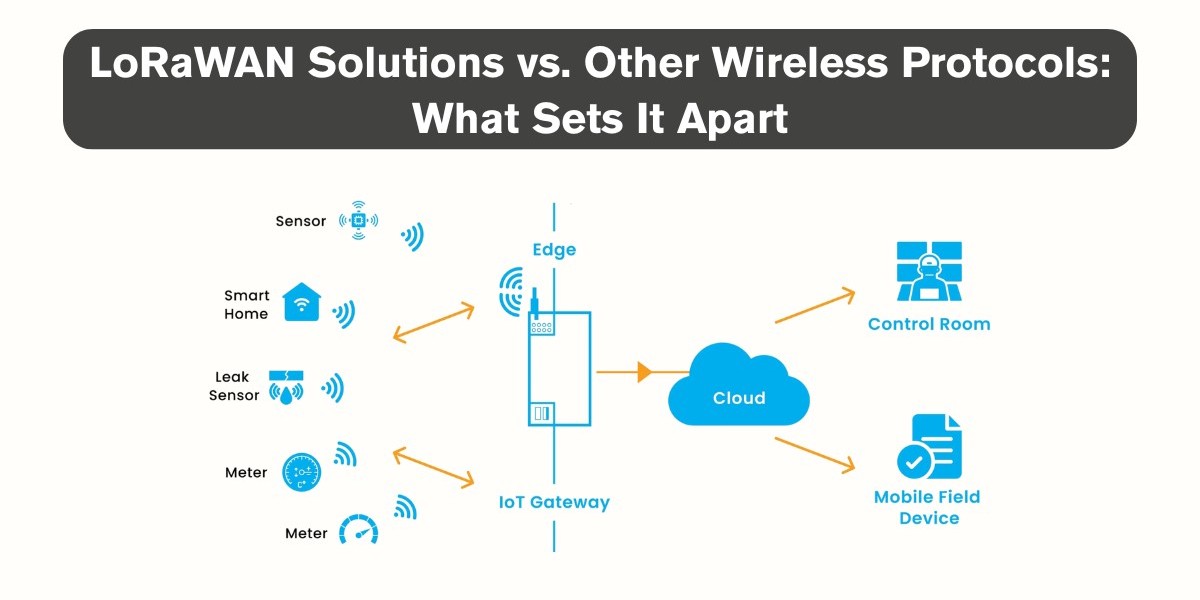Wireless communication plays a critical role in modern Internet of Things (IoT) deployments. Choosing the right wireless protocol affects device connectivity, power consumption, network range, and overall system costs. Among the many options available, LoRaWAN solutions have gained significant attention.
Understanding LoRaWAN Solutions
LoRaWAN (Long Range Wide Area Network) is a low-power, wide-area networking protocol designed specifically for IoT devices requiring long-range communication and low energy use. It operates on unlicensed frequency bands, such as 868 MHz in Europe and 915 MHz in the US.
LoRaWAN solutions focus on connecting battery-powered sensors over several kilometers while maintaining low data rates and extended battery life. Typical use cases include smart agriculture, asset tracking, environmental monitoring, and smart cities.
Key Features of LoRaWAN-Based Solutions
Long Range Communication: LoRaWAN devices can communicate over distances ranging from 2 to 15 kilometers in urban and rural environments, respectively.
Low Power Consumption: Devices can run on small batteries for years, reducing maintenance.
Low Data Rates: Designed for small packets of data sent infrequently, typically a few bytes every several minutes or hours.
Star-of-Stars Topology: End devices connect to gateways, which forward data to centralized network servers.
Unlicensed Spectrum Use: No licensing fees reduce deployment costs.
Comparing LoRaWAN Solutions with Other Wireless Protocols
Below, we analyze LoRaWAN alongside common alternatives used in IoT: Wi-Fi, Bluetooth, Zigbee, NB-IoT, and Sigfox.
1. LoRaWAN vs. Wi-Fi
Range: Wi-Fi works up to 100 meters indoors. LoRaWAN supports communication across 2–15 kilometers in urban and rural environments.
Power Usage: Wi-Fi drains battery quickly. LoRaWAN enables multi-year operation on small batteries with minimal power draw per transmission.
Data Throughput: Wi-Fi supports fast data rates up to 1 Gbps. LoRaWAN sends small data packets slowly between 0.3 to 50 kbps.
Use Cases: Wi-Fi fits high-bandwidth devices like laptops or cameras. LoRaWAN supports sensors that send minimal data over long distances.
2. LoRaWAN vs. Bluetooth Low Energy (BLE)
Range: BLE works within 10–50 meters. LoRaWAN extends well beyond that, often operating over kilometers.
Power Consumption: Both are low power, but LoRaWAN transmits less frequently, giving longer battery life in remote deployments.
Topology: BLE uses mesh networks for device relaying. LoRaWAN uses a central gateway to connect all end devices.
Data Rate: BLE supports 1–2 Mbps for faster data. LoRaWAN transmits at much lower bitrates for occasional updates.
Ideal Scenarios: BLE suits wearables or phones. LoRaWAN supports agricultural sensors or remote utility monitoring.
3. LoRaWAN vs. Zigbee
Range: Zigbee covers 10–100 meters. LoRaWAN spans kilometers, ideal for large outdoor or industrial spaces.
Network Architecture: Zigbee builds mesh networks with device hops. LoRaWAN connects directly from sensor to gateway.
Power Use: Zigbee nodes relay data, increasing power use. LoRaWAN nodes only transmit, conserving energy.
Data Rate: Zigbee supports up to 250 kbps. LoRaWAN handles smaller payloads at slower rates.
Typical Uses: Zigbee fits homes and buildings. LoRaWAN works better for outdoor, industrial, or municipal sensor networks.
4. LoRaWAN vs. NB-IoT (Narrowband IoT)
Range and Coverage: NB-IoT uses licensed cellular bands with strong signal penetration. LoRaWAN offers similar coverage over unlicensed frequencies.
Power Consumption: Both have long battery life. LoRaWAN uses less power during idle and deep sleep states.
Data Rate: NB-IoT supports up to 250 kbps. LoRaWAN transmits smaller data packets more slowly.
Cost: NB-IoT requires carrier plans and SIMs. LoRaWAN avoids fees using unlicensed spectrum.
Deployment: NB-IoT needs telecom providers. LoRaWAN allows public or private infrastructure deployment.
5. LoRaWAN vs. Sigfox
Range: Both reach long distances on unlicensed bands. Coverage varies slightly by geography and antenna setup.
Power Use: Both focus on long battery life. LoRaWAN may transmit less often with greater control over power cycles.
Data Throughput: Sigfox allows only 12-byte payloads and 140 messages/day. LoRaWAN supports up to 243 bytes and more frequent transmissions.
Network Control: Sigfox is operator-managed only. LoRaWAN supports both private and public networks.
Flexibility: LoRaWAN provides full control over setup, device limits, and network behavior. Sigfox has strict message and payload constraints.
Advantages of LoRaWAN Solutions
Scalability: LoRaWAN supports thousands of devices per gateway, making it ideal for large-scale IoT networks across cities, agriculture, utilities, or industrial environments.
Cost-Effective: Operating on unlicensed spectrum removes carrier fees and license costs, reducing deployment expenses for both public and private IoT network infrastructures.
Security: LoRaWAN includes AES-128 encryption at both network and application layers, protecting data integrity and confidentiality across all communication levels.
Global Adoption: Backed by the LoRa Alliance, LoRaWAN offers standardized protocols, ensuring compatibility among devices and solutions from multiple global vendors.
Technical Challenges and Considerations
1. Limited Data Rate
LoRaWAN supports only low data rates, typically between 0.3 and 50 kbps. This limitation makes it unsuitable for applications that require large data transfers, such as video streaming, high-resolution images, or frequent telemetry from complex industrial systems.
2. Duty Cycle Restrictions
Devices operating on LoRaWAN in unlicensed frequency bands must follow strict duty cycle regulations. These rules limit the total transmission time per hour, which can impact message frequency and delay data delivery in time-sensitive applications or dense deployments.
3. Interference
LoRaWAN operates in unlicensed ISM bands that are shared with many other technologies. This makes it vulnerable to interference and signal collisions, especially in urban or industrial environments where multiple wireless devices compete for the same spectrum.
4. Latency
LoRaWAN is designed for delay-tolerant communications. Its architecture introduces latency due to low transmission frequency and asynchronous communication. It cannot support real-time applications like industrial automation, emergency response systems, or time-critical control loops.
Real-World Examples of LoRaWAN Solutions
1. Smart Agriculture
LoRaWAN sensors help farmers collect real-time data on soil moisture, temperature, and weather conditions. This enables precise irrigation control, reduces water usage, and improves crop yields by supporting data-driven agricultural practices over wide, rural areas with minimal infrastructure.
2. Asset Tracking
Logistics companies use LoRaWAN to track containers, pallets, and vehicles across large geographic areas. This solution avoids recurring cellular network fees, offers long battery life, and provides location and condition updates for enhanced visibility and operational efficiency.
3. Smart Cities
Cities implement LoRaWAN networks to manage infrastructure such as parking systems, streetlights, and air quality sensors. These low-power devices transmit periodic data, enabling automation, reducing operational costs, and improving urban planning and environmental monitoring without heavy communication overhead.
Conclusion
LoRaWAN-based solutions offer unique advantages for IoT use cases requiring long-range, low-power, and low-cost connectivity. While other wireless protocols serve higher data rates or shorter distances, LoRaWAN fills the niche for wide-area sensor networks. Understanding these trade-offs helps businesses select the best wireless technology for their specific needs.







